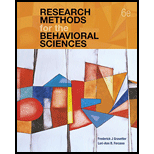
Research Methods for the Behavioral Sciences (MindTap Course List)
6th Edition
ISBN: 9781337613316
Author: Frederick J Gravetter, Lori-Ann B. Forzano
Publisher: Cengage Learning
expand_more
expand_more
format_list_bulleted
Concept explainers
Textbook Question
Chapter 1, Problem 10E
Describe what it means to say that science is empirical, public, and objective, and explain why each of these principles is important.
Expert Solution & Answer
Trending nowThis is a popular solution!

Chapter 1 Solutions
Research Methods for the Behavioral Sciences (MindTap Course List)
Ch. 1.1 - Compare and contrast the nonscientific methods for...Ch. 1.2 - Identify and describe the steps of the scientific...Ch. 1.2 - Define induction and deduction and explain the...Ch. 1.2 - Distinguish between a hypothesis and a prediction.Ch. 1.2 - Explain what it means to say that the scientific...Ch. 1.2 - Prob. 6LOCh. 1.3 - Distinguish between qualitative and quantitative...Ch. 1.3 - Identify and describe the steps in the research...Ch. 1 - In addition to the key words that were defined in...Ch. 1 - Describe how some behaviors can be explained by...
Ch. 1 - Describe why you might be cautious about using the...Ch. 1 - Suppose that you are debating whether to hitchhike...Ch. 1 - According to the gamblers fallacy, if a coin toss...Ch. 1 - In this chapter, we identified the method of...Ch. 1 - What are the five steps of the scientific method?Ch. 1 - Describe the difference between inductive and...Ch. 1 - State a hypothesis that identifies a specific...Ch. 1 - Describe what it means to say that science is...Ch. 1 - An expert appears on a shopping network to explain...Ch. 1 - A social science researcher would like to...
Knowledge Booster
Learn more about
Need a deep-dive on the concept behind this application? Look no further. Learn more about this topic, statistics and related others by exploring similar questions and additional content below.Similar questions
- A Bitter Dispute With the publication of Ars Magna, a dispute intensified between Jerome Cardan and another mathematician named Niceolo Fontana, otherwise known as Tartaglia. What was the dispute, and how did it arise? In your opinion, who was at fault? Write a paragraph or two about your findings.arrow_forwardAlthough Pythagoras preceded William Shakespeare by 2,000 years, the philosophy of the Pythagoreans is mentioned in Shakespears The Merchant of Venice. Here is a quote from that play: Thou almost makst me waver in my faith, To hold opinion will Pythagoras, That souls of animals infuse themselves Into the trunks of men. Research the Pythagoreans. What were the main beliefs held by their society? What part of the philosophy of the Pythagoreans was Shakespeare referring to specifically with this quote? What present-day religions share a similar belief? Write a paragraph or two about your findings.arrow_forwardCholesterol Cholesterol in human blood is necessary, but too much can lead to health problems. There are three main types of cholesterol: HDL (high-density lipoproteins), LDL (low-density lipoproteins), and VLDL (very low-density lipoproteins). HDL is considered “good” cholesterol; LDL and VLDL are considered “bad” cholesterol. A standard fasting cholesterol blood test measures total cholesterol, HDL cholesterol, and triglycerides. These numbers are used to estimate LDL and VLDL, which are difficult to measure directly. Your doctor recommends that your combined LDL/VLDL cholesterol level be less than 130 milligrams per deciliter, your HDL cholesterol level be at least 60 milligrams per deciliter, and your total cholesterol level be no more than 200 milligrams per deciliter. (a) Write a system of linear inequalities for the recommended cholesterol levels. Let x represent the HDL cholesterol level, and let y represent the combined LDL VLDL cholesterol level. (b) Graph the system of inequalities from part (a). Label any vertices of the solution region. (c) Is the following set of cholesterol levels within the recommendations? Explain. LDL/VLDL: 120 milligrams per deciliter HDL: 90 milligrams per deciliter Total: 210 milligrams per deciliter (d) Give an example of cholesterol levels in which the LDL/VLDL cholesterol level is too high but the HDL cholesterol level is acceptable. (e) Another recommendation is that the ratio of total cholesterol to HDL cholesterol be less than 4 (that is, less than 4 to 1). Identify a point in the solution region from part (b) that meets this recommendation, and explain why it meets the recommendation.arrow_forward
Recommended textbooks for you
 Holt Mcdougal Larson Pre-algebra: Student Edition...AlgebraISBN:9780547587776Author:HOLT MCDOUGALPublisher:HOLT MCDOUGAL
Holt Mcdougal Larson Pre-algebra: Student Edition...AlgebraISBN:9780547587776Author:HOLT MCDOUGALPublisher:HOLT MCDOUGAL Trigonometry (MindTap Course List)TrigonometryISBN:9781305652224Author:Charles P. McKeague, Mark D. TurnerPublisher:Cengage Learning
Trigonometry (MindTap Course List)TrigonometryISBN:9781305652224Author:Charles P. McKeague, Mark D. TurnerPublisher:Cengage Learning

Holt Mcdougal Larson Pre-algebra: Student Edition...
Algebra
ISBN:9780547587776
Author:HOLT MCDOUGAL
Publisher:HOLT MCDOUGAL

Trigonometry (MindTap Course List)
Trigonometry
ISBN:9781305652224
Author:Charles P. McKeague, Mark D. Turner
Publisher:Cengage Learning

Probability & Statistics (28 of 62) Basic Definitions and Symbols Summarized; Author: Michel van Biezen;https://www.youtube.com/watch?v=21V9WBJLAL8;License: Standard YouTube License, CC-BY
Introduction to Probability, Basic Overview - Sample Space, & Tree Diagrams; Author: The Organic Chemistry Tutor;https://www.youtube.com/watch?v=SkidyDQuupA;License: Standard YouTube License, CC-BY